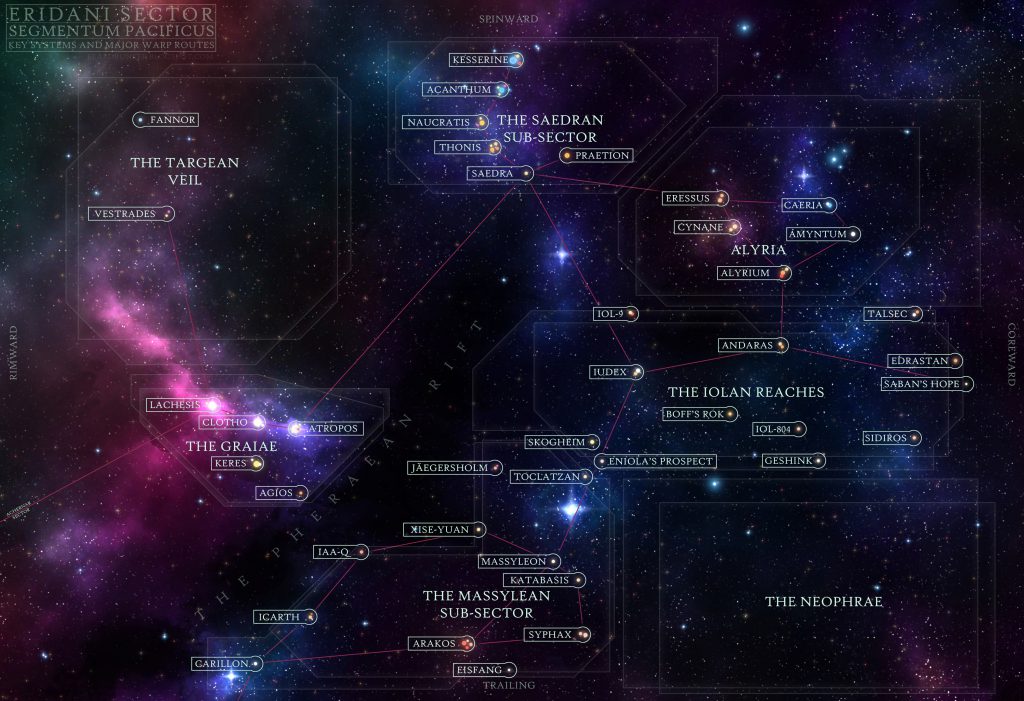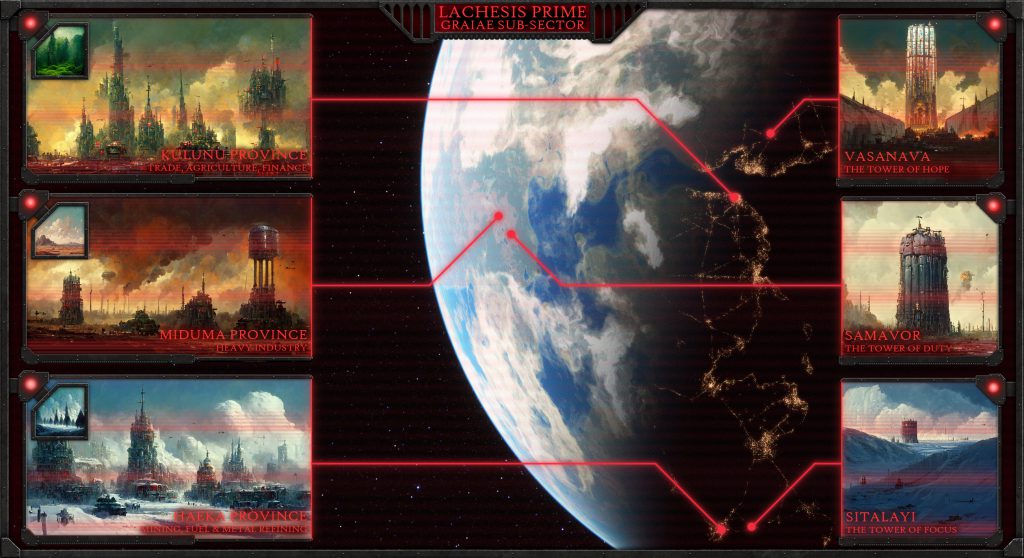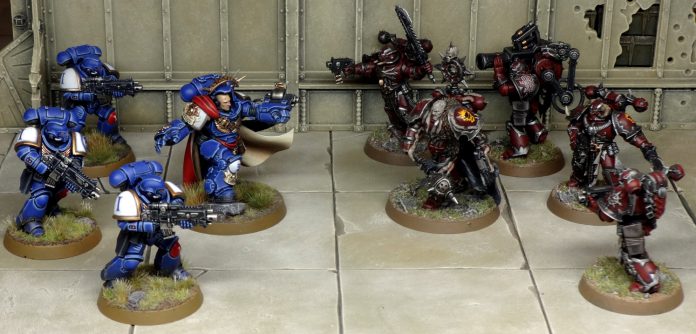In this five part series I’m hoping to show how easy it is to turn your games of 40K Crusade into a campaign. Today we’re going over the rules, the lore and the map. Next time we’ll show off the armies, after which the stage is set for a showdown between two bitter rivals: the Word Bearers (plus allies) and Ultramarines Successors the Cobalt Scions (and their allies). Vengeance for Calth! Or possibly Monarchia.
The time limit for our campaign was a single week, bookended by the weekends. Fifteen battles spread over nine days. Bloody luxury. The way everyone’s calendars worked out, we were going to get way more players at the start rather than the end, but on the upside, this meant the conflict would become extra focused on the bitter foes at the heart of the story as it went on. Speaking of story, the victory conditions were only marginally more complex than “who won the most games?” but they gave us the scaffolding for a satisfying narrative to emerge over the course of the week.
If you’re not that familiar with narrative 40K, my hope is to demystify it somewhat by sharing how we made the sausage. If you’re a seasoned narrative nutter then I hope there’s a few ideas in here that might enrich your toolkit. If nothing else, the series should offer any and all Warhams some vicarious hobby joy.
What’s in the series?
This post: rules, maps, artwork, lore.
Part 2: The players that fought in the campaign, and their armies.
Part 3: The beginning, in which there are Imperial heroics.
Part 4: The middle, in which Bad Things occur.
Part 5: The end, in which things end up being closer than expected.
The Lore
Three of us got together to discuss the lore and the victory conditions in advance, but I don’t want to start this series by forcing you, dear reader, to trawl through a page of homebrew fluff. Instead, you can discover what’s going on from the Imperial perspective, which is easy, because at the start they know almost bugger all. That said, it’s Word Bearers, so you’ve already guessed the glib version of their plan: ‘do a big evil ritual.’
The Imperium’s only warning of the Lachesis Raid came from the premonitions of Tolemias, a young Librarian of the closest Astartes Chapter. Despite misgivings from the other librarians, Cobalt Scions Chapter Master Drusus found Tolemias’ conviction compelling. The two of them requisitioned a small force from the Third Company and set out for the Lachesis system aboard the strike cruiser Axios.
Lachesis Prime wasn’t an obvious choice for a raid. The system’s one idiosyncrasy was the high incidence of psykers within its population, a feature of all the worlds in the Graiae sub-sector of Eridani. As a precaution, Drusus ensured all three of the planet’s Psykana holding towers were garrisoned by the Imperial Guard, then he and Tolemias awaited the enemy’s arrival, with the Cobalt Scions acting as a rapid response force.

The lore for Lachesis Prime itself emerged as a byproduct of making a map of the place. We had that stuff figured out up front, but we’ll cover those as they become relevant to the story in parts 3, 4 and 5.
The Prep Stage, or, I done a Arts
The Map
I didn’t need to make a map for this campaign. It’s just a very, very elaborate way of having six names and a place to keep a tally. So why did I make it? Well, I enjoy this sort of thing, but also because I find making a map forces you to flesh the place out a little. This, in turn, makes it easier to come up with ideas for missions to play. Finally, and perhaps most importantly, I think it helps with immersion.
To ensure we got a variety of scenery on the table, I gave Lachesis (La-key-sis) a mix of temperate, arid and icy biomes. Also I made up some names, endeavouring to avoid the default 40K cod-Latin just to get an entirely unearned sense of specificity. The Imperium’s a culturally varied place, albeit a consistently oppressive one.

How the map was made
The image of the planet is a screenshot from SpaceEngine, a procedural simulation of the universe. The city lights were painted in afterwards in Photoshop. The images of the biomes, provinces and towers were all generated using the Midjourney AI, with some modest touch ups and screen artifacts added in Photoshop. The grungy metal frames were painted from scratch, again in Photoshop. To be fair I could’ve saved myself a bunch of time by just doing glowy lines or whatever, but it was fun to give that old school look a try. As always when doing this sort of thing, it enhanced my respect for proper illustrators who do this to much higher standards.
If you’d like a more detailed explanation of making the map, I wrote about it over at the Beard Bunker.
Faction Icons
The map was just the tip of the artberg. I wanted an icon for each faction taking part (again, seriously, you could keep a tally in a Google doc next to six region names, I just enjoy this shit). Writing up your hobby bullshit for a website like Goonhammer means you can’t get away with using others’ art assets for personal use, because you’re going to go and talk about it in public. This means you need to have the rights to use the image, and the most scorched earth way of achieving that is to make it yourself.
Again, these are of course surplus to technical requirements, but at least one of the players got extremely pumped to see their faction icon brought to life for the campaign map.
Future use
One of the benefits of doing all this map stuff is that it’s created art assets I can use in future campaigns, particularly if/when we return to Lachesis Prime itself. All the icons and interface elements can be easily moved around and repurposed to another background image.
Rules & Victory Conditions
Factions
This is a campaign for two factions: the Imperium, and the forces of Chaos. In theory we could have had Eldar come in on the Imperium’s side, but ultimately we preferred the idea of a focused story. The one player we have who didn’t own either an Imperial or Chaos army decided she’d use it as an excuse to borrow an Imperial Guard force and try them out.
Rules
Before each game, the Chaos player picks a region on the map to attack. There are six regions: three large provinces, and three Psykana towers. They can attack each region as many times as they like, but if a Chaos army wins a battle fought over a tower, that tower is destroyed, and cannot be fought over again.
The map indicates what sort of biome each province/tower has. This is a purely visual thing to help inform what sort of terrain to deploy, hopefully imparting a consistent sense of place.
While the Chaos player decides which region to attack, the players are expected to mutually agree on a mission they’d like to play. The Imperial player might be mounting a counter-offensive, the Chaos lads might be trying to achieve their ends through a ritual rather than an all-out assault – in other words, let your imagination run rampant, and pick a mission to match it, or even come up with your own! Ultimately, the victor will be free to do what they want in the aftermath.
The winner of each battle places a copy of their faction icon on the province or tower they fought over on the campaign map.
Victory Conditions
Note: This is stacked in Chaos’ favour since we felt that would be narratively more interesting for our corner of the galaxy, but that it would be fun for an Imperial victory to at least be possible.
If the armies of the Imperium collectively win 75% of their games, the Word Bearers’ evil plan will fail. If the armies of Chaos collectively win 60% of their games, and win at least one game on each of the Psykana towers, the plan is a total success. Any other result is a marginal victory for Chaos, since the gods are pleased when things are on fire.
You went to all that trouble and it just comes down to a win/loss ratio?
Yes. I love a complex campaign system, but for this one we just wanted a barebones framework. And like I said at the start, a campaign really doesn’t have to be complicated to add some continuity and tension to your games.
Moreover, we’re narrative players. Most of the juice doesn’t come from rules, but in how the characters interact with their adversaries, and the long-term narrative consequences for our home-brewed sector of the galaxy. We found the simple act of having separate provinces and three key locations helped get the mental ball rolling enough to come up with some fun missions.
Next time…
…We’re going to introduce the players and their armies. If you have thoughts or questions about the artwork, rules or anything else in today’s post, harangue me in the comments or yeet your insights at contact@goonhammer.com.
And if you’re looking for the best tool around for managing and tracking your own campaigns, check out Administratum.



